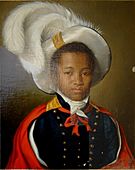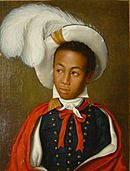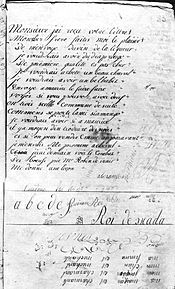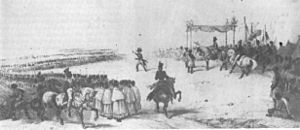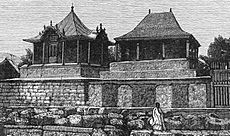Radama I facts for kids
Quick facts for kids Radama I |
|||||
|---|---|---|---|---|---|
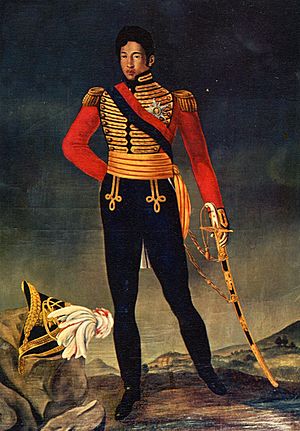 |
|||||
| King of Madagascar | |||||
| Reign | 1810 – 27 July 1828 | ||||
| Coronation | 1810 | ||||
| Predecessor | Andrianampoinimerina | ||||
| Successor | Ranavalona I | ||||
| Born | c. 1793 Ambohimanga, Madagascar |
||||
| Died | 27 July 1828 (age 35) Rova of Antananarivo |
||||
| Burial | c. 1828 Tomb of Radama I, Rova of Antananarivo |
||||
| Spouse | Ramavo Rasalimo |
||||
| Issue | Raketaka | ||||
|
|||||
| Father | Andrianampoinimerina | ||||
| Mother | Rambolamasoandro | ||||
Radama I (born around 1793, died 1828) was a very important king in Madagascar. He was the first ruler of Madagascar to be officially recognized as "King of Madagascar" by a European country. This happened during his rule from 1810 to 1828.
Radama became king when he was just 18 years old, after his father, King Andrianampoinimerina, passed away. He invited Europeans, especially missionaries from the London Missionary Society, to his kingdom. These visitors helped set up schools, teaching people how to read and write, and also introduced new skills. Radama also made big changes, like stopping the international slave trade. He was a strong leader who united a large part of the island under his rule through military campaigns. He died at 35 and was followed by his wife, Ranavalona I.
Contents
Early Life of Radama I
Radama was the son of King Andrianampoinimerina and Rambolamasoandro. His father ruled the growing Kingdom of Imerina in the central part of Madagascar, near Antananarivo. As a child, Radama learned to read the Malagasy language using a special script called Sorabe. This script was based on Arabic letters and used by court astrologers.
When he was young, Radama joined his father on a military trip. They went to calm down the Betsileo people who had broken an oath to his father. Radama led one part of the army, which was his first chance to command soldiers. He successfully helped bring several towns in Betsileo under control. His father told him that his goal was to make the sea the border of his kingdom. Radama promised to make this dream come true.
Radama I's Reign
In 1810, Radama became king of Imerina at 18. Some areas that his father had conquered rebelled when they heard of his death. Radama quickly led his army to stop these uprisings. He successfully put down the rebellions and made his position as king strong. He also finished bringing the Betsileo kingdom under his control.
Working with the British
In 1816, Radama was contacted by a trader from Mauritius. This trader was sent by the British Governor, Robert Townsend Farquhar. The British wanted to become more influential in Madagascar and stop the French from setting up trading posts again. As a result, two of Radama's half-brothers, Rahovy and Ramarotafika, were sent to study in Mauritius.
Later, in 1817, Radama signed an important agreement with the British. This treaty recognized Radama as "King of Madagascar." In return, he received horses and uniforms from the British. He also promised to stop the export of slaves. The British then opened a diplomatic office on the island.
Education and New Ideas
In 1820, Radama met two missionaries, David Jones and David Griffiths, from the Protestant London Missionary Society (LMS). They had started a small school. Radama was very impressed and wanted to have similar schools all over his kingdom.
Within a year, he opened 23 schools with 2,300 students, including many girls. He asked the LMS missionaries to help write down the Malagasy language using the Latin alphabet. This was a huge step for literacy in Madagascar. Missionaries, like James Cameron, also helped set up new industries. These included carpentry, leatherwork, and printing. They even translated and printed Bibles in Malagasy.
Radama was not always keen on old traditions. He seemed to doubt the importance of the sampy, which were 12 royal idols central to the Merina court. Many of the new ideas and technologies he brought in were not liked by everyone. Some people felt these changes went against their ancestors' traditions.
Modernizing the Army
With help from the British, Radama's army became very strong. This allowed him to unite the island by force. Radama admired Napoleon Bonaparte and used European military ideas to make his army modern. He even had French, British, and Jamaican generals helping him.
In every new area he conquered, Radama built military bases called rova. These were like smaller versions of his main palace, the Rova of Antananarivo. He sent Merina people, called voanjo (meaning "peanuts"), to live and work in these new areas.
Uniting Madagascar
Radama's plan to expand his kingdom started in 1817. He first took control of the eastern port town of Toamasina. Then, he moved west into Menabe in 1820, 1821, and 1822. The next year, he sent armies along the northeast coast. They set up military posts in places like Maroantsetra and Mananjary.
By 1824, he had posts in Vohemar, Diego Suarez, and Mahajanga. In 1825, he established posts in the southeastern towns of Farafangana and Fort Dauphin. He defeated the Antalaotra people in 1826. Radama also launched campaigns against the Antanosy and Betsimisaraka to bring them under his rule. His last military campaign was in 1827, when he conquered the Antesaka. The northern Tanala also became part of his kingdom. In total, Radama united two-thirds of Madagascar under his rule.
Death and Succession
Radama died on July 27, 1828, at his home in the Tranovola. He was only 35 years old.
Radama was buried in a stone tomb at the Rova of Antananarivo. His tomb had a special "sacred house" on top, which was a traditional sign of royalty in Madagascar. Like his father and other Merina kings, he was buried in a silver coffin. People say his tomb had the most treasures of any tomb in Madagascar. These included silk clothes, paintings, thousands of coins, jewels, and gold vases. Most of these items were lost in a fire in 1995 that destroyed the Rova of Antananarivo.
Radama did not clearly name who should be king after him. According to custom, his nephew, Rakotobe, should have been the next ruler. However, some powerful military officers supported Radama's highest-ranking wife, Ramavo. She eventually became Queen Ranavalona I.
See also
 In Spanish: Radama I para niños
In Spanish: Radama I para niños


